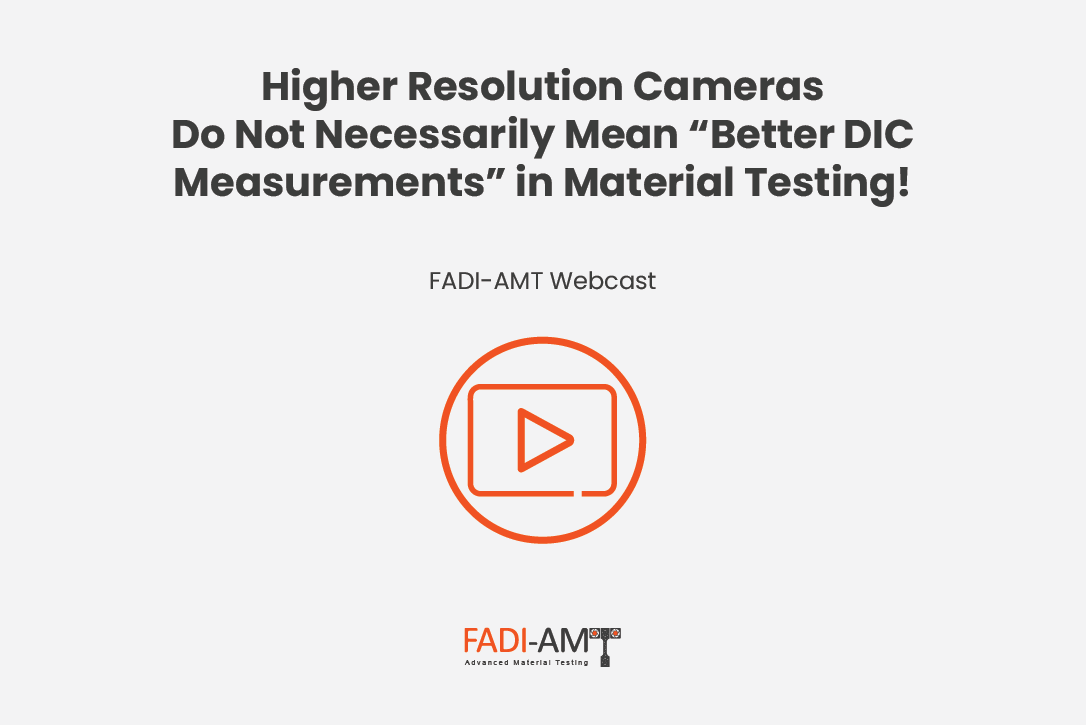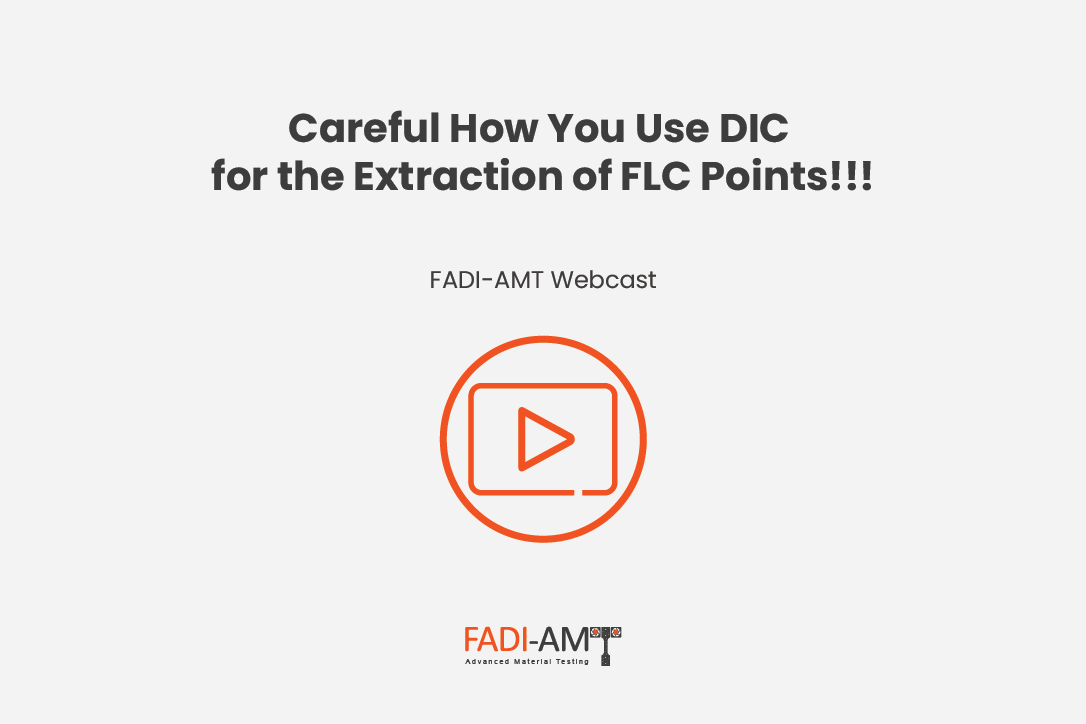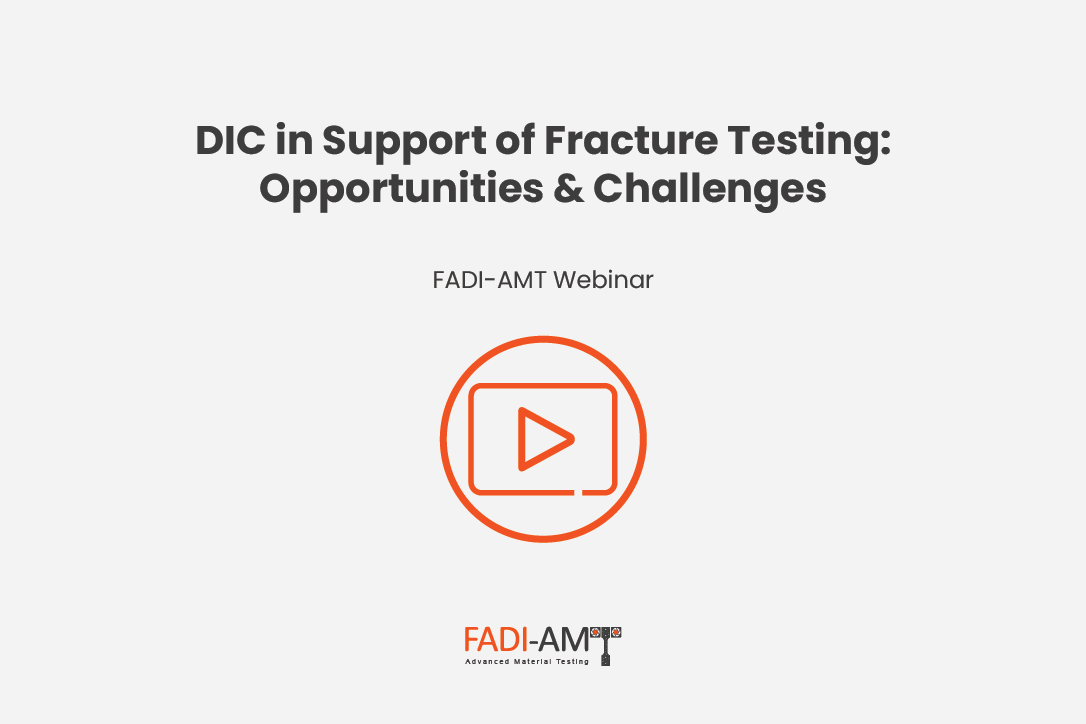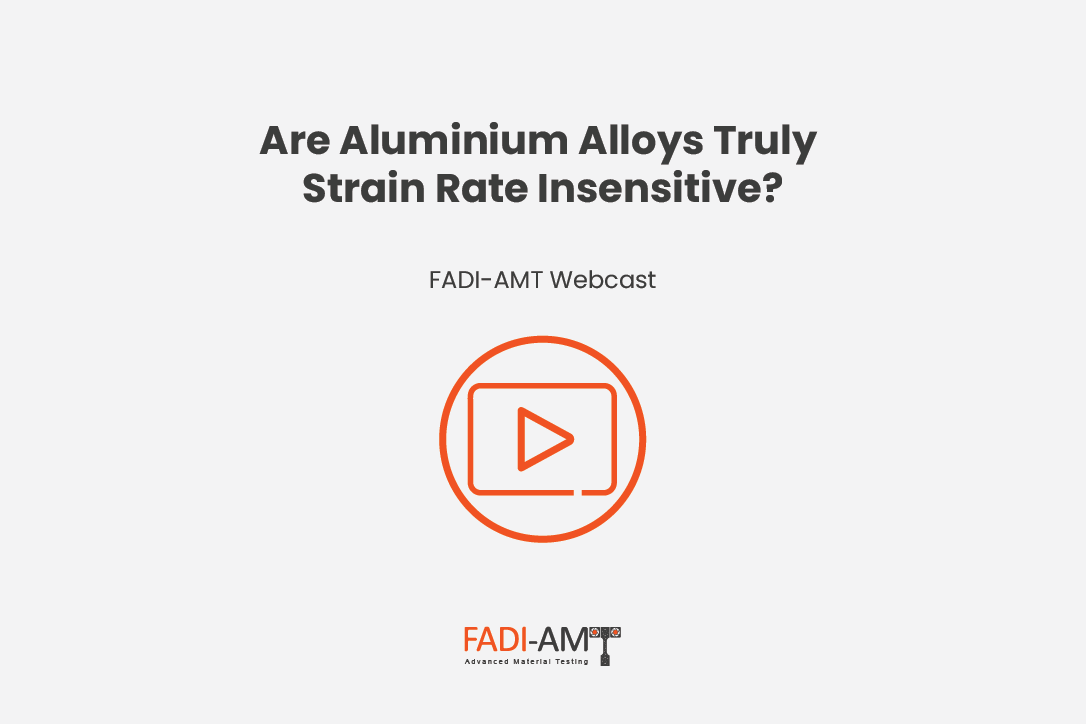Webinars & Webcasts
Past Recordings
The Reveal Event of "material insights"!
Webinar
(90 minutes)

FADI-AMT Webinar
30th of August 2023
Description:
"NEW Vision ... NEW Platform ... NEW Products ... FADI-AMT is not only expanding its "Material Testing Services", but rather evolving to bring you a "new Platform" of cohesive products & tools, all serving ONE goal: "Providing you access to high quality Material DATA for research & development purposes"
Get to know our new platform:
- A totally NEW & Elevated standard for Material Testing!
- NEW Hardware & Software tools to help you maximize the output of your testing machines!
- NEW transformative ways for accessing R&D-level material DATA!
- Seamless technical support for all CAE activities!
Click here to watch the Webinar
Higher Resolution Cameras Do Not Necessarily Mean “Better DIC Measurements” in Material Testing! (Part-II)
Webcast
(30 minutes)

FADI-AMT Webcast (Part-II)
26th April - 2nd of May 2023
Presented by: Dr. Fadi Abu-Farha (Tech. Manager at FADI-AMT LLC)
Description:
There are many misconceptions about camera resolution and accuracy of measurement when coupling DIC in material testing. Many believe that higher resolution is automatically better! Many worry too much about increasing the overall resolution level without paying much attention to other potentially more important parameters, such as frame rate! This webcast takes a deep dive into the whole business of camera resolution in material testing with DIC!!!
Featured Topics:
- Digital Image Correlation (DIC)
- High Speed Digital Image Correlation (HS DIC)
- DIC Hardware
- Spatial Resolution in DIC Measurements
- Material Testing
Click here to watch the Webcast
Higher Resolution Cameras Do Not Necessarily Mean “Better DIC Measurements” in Material Testing! (Part-I)
Webcast
(30 minutes)

FADI-AMT Webcast (Part-I)
19th - 25th of March 2023
Presented by: Dr. Fadi Abu-Farha (Tech. Manager at FADI-AMT LLC)
Description:
There are many misconceptions about camera resolution and accuracy of measurement when coupling DIC in material testing. Many believe that higher resolution is automatically better! Many worry too much about increasing the overall resolution level without paying much attention to other potentially more important parameters, such as frame rate! This webcast takes a deep dive into the whole business of camera resolution in material testing with DIC!!!
Featured Topics:
- Digital Image Correlation (DIC)
- High Speed Digital Image Correlation (HS DIC)
- DIC Hardware
- Spatial Resolution in DIC Measurements
- Material Testing
Click here to watch the Webcast
YES … Even Forming Limit Curves Can Be Obtained with 2D DIC!
Webinar
(60 minutes)

FADI-AMT Webinar (60 minutes)
22nd of February 2023
Presented by: Dr. Fadi Abu-Farha (Tech. Manager at FADI-AMT LLC) Guest Speaker: Dr. Akshat Agha (Material Testing and Development Engineer at FADI-AMT LLC)
Description:
Through a series of previous webinars & webcasts over the past two years, we have been demonstrating the power of 2D Digital Image Correlation (2D DIC) in transforming the way we perform material testing by improving and enriching what was conventionally possible with strain gages and extensometers, and opening the doors for measurements that were not possible before. The main objective has been to promote researchers and testing specialists to take advantage of the power of DIC in spite of the high cost and relative complexity associated with 3D DIC.
In this webinar, we go further by expanding the limits of 2D DIC into complex tests that involve out-of-plane deformation! Our focus in this webinar will be on forming limit curves (FLC) testing, a very important test for the automotive sheet metal forming sector, and one known to require stereo (3D) DIC systems and complex post-DIC algorithms for extracting FLC data points. We will show direct comparisons between 2D and 3D DIC measurements in order to demonstrate how, if done correctly, 2D DIC can match (with negligible deviations) the output of 3D DIC!
Featured Topics:
- Sheet Stretching Formability Tests (Nakajima & Marciniak)
- 2D Digital Image Correlation (2D DIC)
- 2D Digital Image Correlation (2D DIC)
- Forming Limit Curves (FLCs) & Diagrams (FLDs)
- Section Method and LBF Method
- ISO 12004-2 Standard
- Finite Element Forming Simulations
Click here to watch the Webinar
Careful How You Use DIC for the Extraction of FLC Points!!!
Webcast
(30 minutes)

FADI-AMT Webcast (30 minutes)
18th - 24th of December 2022
Presented by: Dr. Fadi Abu-Farha (Tech. Manager at FADI-AMT LLC)
Description:
In sheet formability testing per ISO 12004-2, many DIC-processing and post-processing parameters could have significant impact on the extracted FLC points; unfortunately, the user may not realize their impact simply because they are hidden or implicitly related to hard settings in commercial DIC software. This webcast addresses this important issue, highlighting the pitfalls and issues that usually lead to discrepancies in FLC results within or across different testing labs.
Featured Topics:
- Sheet Stretching Formability Tests (Nakajima & Marciniak)
- Stereo Digital Image Correlation (DIC)
- Forming Limit Curves (FLCs) & Diagrams (FLDs)
- Section Method and LBF Method
- ISO 12004-2 Standard
- Finite Element Forming Simulations
Click here to watch the Webcast
DIC in Support of Fracture Testing: Opportunities & Challenges
Webinar
(60 minutes)

FADI-AMT Webinar (60 minutes)
16th of November 2022
Presented by: Dr. Fadi Abu-Farha (Tech. Manager at FADI-AMT LLC) With
Dr. Jun Hu, guest speaker from Cleveland-Cliffs Steel Corporation (Research & Innovation Center)
Description:
Calibration of fracture models requires a suite of mechanical tests that cover a wide spectrum of loading conditions (the most critical of which are balanced biaxial tension (BBT), plane-strain tension (PST), uniaxial tension (US), and pure shear (SH)). While these tests are well-known, achieving the intended stress-triaxiality that corresponds to each one of these loading cases could be difficult.
In this live webinar, we shed some light on this important topic and present the integration of digital image correlation (DIC) with mechanical testing to support the development and refinement of “fracture testing”. We show how DIC can assist in tracking the evolution of stress-triaxiality in the material, thus enabling the optimization of fracture test sample geometries. On the other hand, we dedicate a significant portion of this webinar to cover the limitations of using DIC in calibrating fracture material cards, highlighting the technical challenges and drawbacks that require significant attention beyond the simple use of DIC as a trusted-tool for reading local strains around the fracture point!
Click here to watch the Webinar
Are Aluminium Alloys Truly Strain Rate Insensitive?
Webcast
(30 minutes)

FADI-AMT Webcast (30 minutes)
23rd - 29th of October 2022
Description:
This webcast sheds some light on the topic of strain rate sensitivity of aluminium alloys; are they all truly insensitive to deformation rate or are there varying degrees of sensitivity depending on the alloy or series! Moreover, how to fully characterize rate sensitivity; by strength? ductility? or other parameters?
The webcast will also cover some of the challenges of high speed material testing and high speed digital image correlation (DIC).
Featured Topics:
- Finite Element Crash Simulations
- Strain Rate Sensitivity of Aluminium Alloys
- Uniaxial Tension Testing at High Speeds
- High-Speed Digital Image Correlation
Click here to watch the Webcast
Sheet Metal Formability Testing with DIC Part-I: For Evolving Automotive Materials ?
Webinar
(60 minutes)
FADI-AMT Webinar
09th of March 2022
Description:
Despite the introduction of new classes of lightweight materials and manufacturing techniques, “stamping” of steel sheets is still the dominant manufacturing approach for mass production of automotive body structures. That being said, there are still many new grades of steel and high strength aluminium alloys that are progressively introduced to the sector, thus posing evolving challenges both in terms of manufacturing and material characterization for forming simulations (FEA).
In this webinar, we shed some light on the topic of “material formability” with focus on the automotive sector. We cover the main formability testing approaches and how they are used to test the wide range of automotive materials. Beyond conventional steels, particular emphasis will be made to addressing the needs of the industry in testing the latest generations of advanced high strength steels and aluminium alloys. Digital image correlation (DIC) is of critical importance to formability testing, thus we dedicate a portion of this webinar to the integration of DIC with formability testing, and the use of DIC to extract FLC points via different algorithms/approaches.
Explore our Youtube channel
YES … 2D DIC is Still Powerful & Effective for Many Material Testing Applications!
Webinar
(60 minutes)
FADI-AMT Webinar
26th of August 2021
Description:
In a recent webinar hosted by ASM International, we presented several cases in which 2D DIC could be used effectively for in-plane mechanical testing, and we showed preliminary data to support this concept. The webinar received significant interest and led to many questions and requests for additional information! In this webinar, we present an expanded more comprehensive study in which detailed direct comparisons between 2D and 3D DIC measurements are carried out for selected material testing scenarios. We share results that demonstrate how 2D DIC can match (with negligible deviations) the output of 3D DIC, if done correctly. The goal is to promote the use of DIC and enable those with limited access to 3D DIC to still take advantage of 2D DIC and capitalize on the benefits it brings in enriching investigations of material deformation & failure.
Note: all project files (images, physical quantities, and even compiled DIC files) will be made available for everyone to process and further evaluate as needed. Some datafiles will be packages specifically for academia for use as training projects in classrooms.
Explore our Youtube channel
Monotonic & Cyclic Testing with DIC for the Calibration of Complex Springback Models
Webinar
(60 minutes)
FADI-AMT Webinar
24th of June 2021
Description:
Prediction of Springback is a very critical topic in sheet metal stamping, not only because of the complex models needed for its prediction, but also because it is difficult to perform the experimental characterization in the first place. There are no standard mechanical testing machines that can fully address the needs of such models without compromises. On the other hand, increased use of lightweight materials (advanced high strength steels with complex microstructures and aluminium alloys with higher strengths) escalates the problems with springback prediction especially that strength-to-stiffness ratios and anisotropy levels are continuously going up.
Therefore, we focus this webinar on presenting solutions to this problem through a set of experimental tools that are particularly designed to generate the data needed for a successful calibration of springback models. Moreover, we also discuss the integration of digital image correlation (both 2D and 3D) into experimental setups to facilitate higher levels of characterization that cannot be achieved by other modes of Extensometry and strain measurements.
Explore our Youtube channel
How Effective is 2D DIC in Material Testing?
Webinar
(60 minutes)
FADI-AMT Webinar, Organized by ASM, ZwickRoell
27th of April 2021
Description:
Digital image correlation (DIC) has become an important tool in material testing practices for the advanced characterization of materials in a wide range of applications. Despite that, the cost of a commercial 3D DIC system might still be a hurdle for many educational institutions, and even for some industrial establishments! 2D DIC is simple, inexpensive and easily attainable, yet it lacks the accuracy and depth of field capabilities of 3D DIC.
Despite this limitation, there are many testing scenarios where material deformation is planar and thus 2D DIC can capture material deformation with sufficient accuracy.
This webinar aims to address this important issue by presenting direct technical comparisons between 2D and 3D DIC measurements for selected material testing scenarios. The ultimate goal is to enable those with limited access to 3D DIC to still take advantage of 2D DIC and capitalize on the benefits it brings in enriching investigations of material deformation & failure.
Explore our Youtube channel
High Strain Rate Tension Testing of Lightweight Materials for Automotive Crash Simulations
Webinar
(60 minutes)
ZwickRoell Virtual Testing Forum in Collaboration with FADI-AMT
12th of November 2020
Description:
This webinar/demo sheds some light on the topic of high strain rate testing, and provides information supported by examples on how reliable high speed material characterization data can be obtained to support automotive CAE crash simulations. An overview of the latest generations of high speed testing machines and systems is first provided, then some testing technical details (test samples, test procedure, the use of DIC, issues with high speed testing, etc.) are discussed.
A live demonstration is also performed to provide hands-on experience and give the audience a feel of the details involved in high rate tension testing. Finally, high speed testing results obtained with some of the latest generations of lightweight automotive materials are presented, and the influence of deformation rate on material behavior is discussed.
Explore our Youtube channel
Digital Image Correlation in Support of Complex Testing of Advanced Materials
Webinar
(60 minutes)
ASM Webinar in Collaboration with FADI-AMT
30th of September 2020
Description:
In this webinar, FADI presented a cohesive story on the state of the art material characterization with digital image correlation (DIC), emphasizing the significant role of DIC in completely transforming the way we investigate deformation and failure in these materials. The webinar featured real-life examples progressing from standard testing systems to more sophisticated experimental setups that are particularly tailored for advanced materials or complex testing conditions. The selected examples cover several important engineering materials and a wide range of unique experiments and conditions that show the versatility and power of DIC.
Explore our Youtube channel